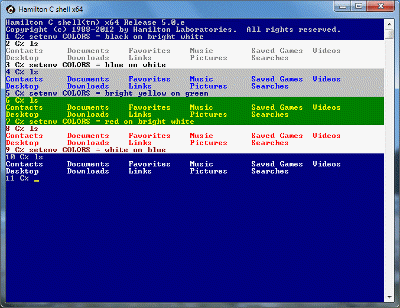
Moves the cursor to the row and column position most recently saved with a Save Cursor Position command. is a number from 1 through 80 that specifies the column where the cursor is located. is a number from 1 through 25 that specifies the row where the cursor is located. Returns the current row and column position of the cursor in the form [ R. You can move the cursor to this location with a Restore Cursor Position command. Stores the current row and column position of the cursor. If you omit both and, DOS moves the cursor to the home position (row 1, column 1-the upper left corner of the screen). If you omit, DOS moves the cursor to column 1. is a number from 1 through 80 that specifies the column to which the cursor is to be moved. To omit but specify, enter the semicolon to show the is omitted. If you omit, DOS moves the cursor to row 1. is a number from 1 through 25 that specifies the row to which the cursor is to be moved. Moves the cursor to the specified row and column. If you omit, DOS moves the cursor left one column.

is a number from 1 through 79 that specifies how many columns the cursor is to be moved left. Moves the cursor left the specified number of columns without changing the row. If you omit, DOS moves the cursor right one column. is a number from 1 through 79 that specifies how many columns that cursor is to be moved right. Moves the cursor right the specified number of columns without changing the row. If you omit, DOS moves the cursor down one row. is a number from 1 through 24 that specifies how many rows the cursor is to be moved down. Moves the cursor down the specified number of rows without changing the column.

If you omit, DOS moves the cursor up one row. is a number from 1 through 24 that specifies how many rows the cursor is to be moved up. Moves the cursor up the specified number of rows without changing the column. Programming Notes - ANSI Escape Sequences Programming The emoji(s, fallback) method allows to emit emojis and other fancy unicodeĬharacters, but fallback to a replacement string if the terminal does not Until explicitly enabled, no escape sequencrs are generated, so the the wrappersīehave transparently: from snazzy import red, enable_colors assert red ( "error" ) = "error" enable_colors ( True ) assert red ( "error" ) = " \x1b [91merror \x1b [39m" Emojis Snazzy is disabled by default, because not all terminals and platforms supportĪlso, when output is redirected to log files, we want to suppress those escapeįinally, a command line tool that uses snazzy might want to offer aĬommand line argument -no-color to disable colors: if not args. (The wrap() methods appends this automatically to the wrapped text.) Enable Colors "reset_underline", "reset_blink", "reset_inverse", "reset_hidden", "reset_all", "reset_fg", "reset_bg", "reset_bold_dim", "reset_italic", The following codes reset distinct formattings to default values: ( "b", "i", and "u" may be used as alias for bold, italic, and underline.) Format Reset

"bold", "dim", "italic", "underline", "blink", "inverse", "hidden", We can also pass RGB tuples like so if the platform supports it: print ( wrap ( "white on blue", ( 255, 255, 255 ), bg = ( 0, 0, 200 ))) Effects These are well supported in most terminals: Note: Not all platforms implement all features The context manager pattern is syntactic sugar for for this explicit code: print ( ansi ( "green", bg = "black" ), end = "" ) print ( "This is so eighties." ) print ( ansi_reset (), end = "" ) Available Formats ColorsĬolor keys can be used as foreground or background using the fg=COLOR and However wrap() is more powerful and flexible, since it also allows to set backgroundĬolor and attributes (bold, italic, underline): print ( wrap ( "white on blue", "white", bg = "blue" )) print ( wrap ( "ERROR:", "yellow", bg = "red", bold = True ) + " that went wrong." )Īlternative pattern, using a context manager: with Snazzy ( fg = "green", bg = "black" )) print ( "This is so eighties." ) ): assert green ( "good" ) = wrap ( "good", fg = "green" ) The function green() is only a convenience shortcut for wrap(. Green foreground color and reset to the default color afterwards. The function green() wraps the text in ANSI escape sequences to apply.snazzy is inactive by default, so we have to call enable_colors() first.

Usage from snazzy import enable_colors, green, wrap enable_colors () print ( "That looks " + green ( "good" ) + ", right?" ) Stylish ANSI terminal colors and helpers.


 0 kommentar(er)
0 kommentar(er)
